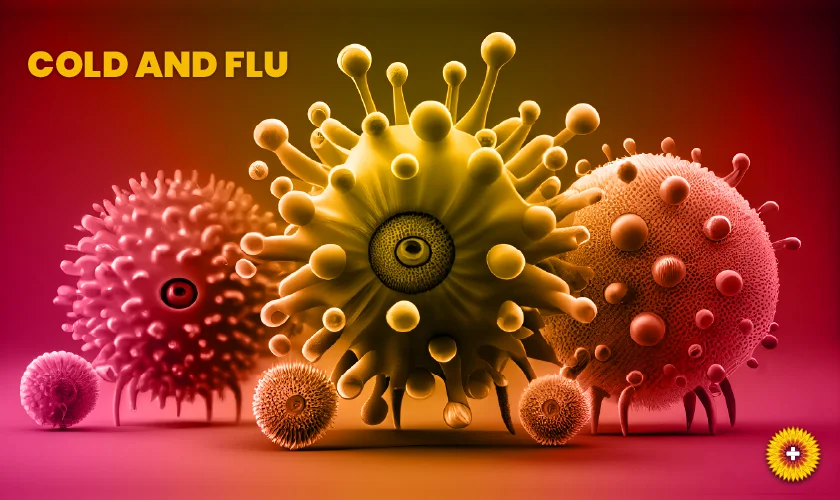The Differences Between Cold or Flu
As the seasons change and temperatures fluctuate, the risk of contracting a cold or flu increases. Both illnesses share similar symptoms, but flu can be more severe. Nobody wants to be sidelined by sickness, whether the common cold or flu. Knowing the differences between these two illnesses can help you take the necessary precautions to protect yourself and your loved ones.
This blog post will explore the key differences between a cold and the flu, how to prevent getting sick, and treatment methods for them.
Table of Contents
Cold vs. Flu: What’s the Difference?
While the common cold and flu are respiratory illnesses, they are caused by different viruses. The common cold is mainly caused by a group of viruses known as rhinoviruses, accounting for 30-50% of all colds, while two viruses, Influenza A and Influenza B, cause the flu. Both illnesses are highly contagious and can be transmitted through droplets when an infected person talks, coughs, or sneezes.
The Difference Between Cold and Flu Symptoms
Although cold and flu symptoms can be similar, there are some differences. Below are the common symptoms of cold and flu:
Cold Symptoms
- Runny/Stuffy Nose (Common)
- Sore Throat (Common)
- Cough (Mild)
- Sneezing (Common)
- Fever (Mild)
- Headache (Occasionally)
- Fatigue (Sometimes)
- Body Aches (Slight)
Flu Symptoms
- Fever (Usually High)
- Sneezing (Sometimes)
- Body Aches (Severe)
- Fatigue (Usual)
- Headache (Common)
- Chest Discomfort (Common)
- Sore Throat (Sometimes)
- Runny/Stuffy Nose (Sometimes)
- Nausea, Vomiting, or Diarrhea (Sometimes)
- Extreme Exhaustion (Usual)
Prevention of Cold and Flu
Preventing the spread of cold and flu is key to avoiding illness altogether. Here are some tips to protect yourself and others:
- Wash your hands frequently with soap and water for at least 20 seconds.
- Use hand sanitizer when soap and water are not available.
- Avoid touching your face, especially your nose, mouth, and eyes.
- Cover your mouth and nose with a tissue or elbow when coughing or sneezing.
- Stay away from people who are sick.
- Avoid close contact with people who have a cold or flu.
- Clean and disinfect frequently touched objects and surfaces at home and work.
Treatment for Cold & Flu
If you feel unwell, seeking medical attention and getting appropriate treatment is essential. Here are some common treatments for cold and flu.
Rest and Hydration
Resting and drinking plenty of fluids are two essential steps in treating colds and the flu. Adequate rest allows your body to focus on fighting off the virus, while hydration keeps your mucous membranes moist and prevents dehydration.
Over-The-Counter Medications
Several over-the-counter (OTC) medications can help alleviate cold and flu symptoms, such as pain relievers, fever reducers, cough suppressants, and decongestants. It is crucial to read the labels and follow the recommended dosages carefully.
Antiviral Medications
Antiviral medications, such as oseltamivir (Tamiflu), zanamivir (Relenza), and peramivir (Rapivab), are prescription drugs that can be used to treat the flu but aren’t used to treat common colds. These medications can shorten the duration of the illness and reduce the risk of complications.
Nasal Irrigation
Nasal irrigation, saline irrigation, or lavage involves flushing the nasal passages with a saltwater solution. This technique can help relieve nasal congestion and reduce the risk of sinus infections.
Steam Therapy
Steam therapy, such as taking a hot shower or inhaling steam from a bowl of hot water, can help relieve congestion and ease breathing. Adding essential oils, such as eucalyptus or peppermint, can also provide additional benefits.
Herbal Remedies
Several herbal remedies, such as echinacea, ginseng, and elderberry, have been traditionally used to treat colds and flu. While scientific evidence for their effectiveness is limited, some people find them helpful.
When To See A Medical Professional
Most cases of cold and flu can be managed at home with rest and over-the-counter medications. However, there are times when you should seek medical attention from a doctor or urgent care provider.
Cold
- Symptoms that last longer than 10 days.
- Severe or worsening symptoms.
- High fever (above 102°F or 39°C).
- Shortness of breath or difficulty breathing.
Flu
- Symptoms that last longer than two weeks.
- Severe or worsening symptoms.
- Chest pain or pressure.
- Shortness of breath or difficulty breathing.
- Bluish lips or face.
- Confusion or disorientation.
Head Cold vs. Chest Cold
You may experience symptoms in different parts of your body when you have a cold. Some people may experience a head cold, while others may experience a chest cold.
Head Cold
A head cold affects the sinuses and upper respiratory system, causing symptoms such as a runny or stuffy nose, congestion, and sinus pressure. Head colds usually accompany a headache, facial pain, and a sore throat.
Chest Cold
A chest cold affects the lower respiratory system, causing symptoms such as a cough, congestion, and difficulty breathing. Chest colds are usually accompanied by wheezing, shortness of breath, and chest discomfort.
Bottom Line
In conclusion, understanding the differences between cold and flu can help you identify your symptoms and take steps to prevent and treat these illnesses. Practice good hygiene, maintain a healthy lifestyle and seek medical attention if necessary. With the right care and treatment, you can quickly recover from a cold or flu and return to your daily routine.
Don’t let cold and flu symptoms slow you down. If you feel under the weather, visit Urgent Care of Kansas for expert medical care and treatment. Our experienced medical professionals are here to help you feel your best, no matter the season.



No comment